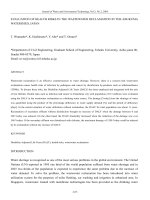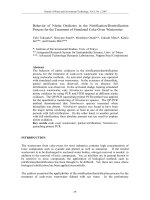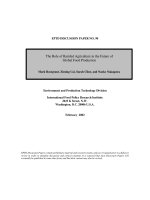- Trang chủ >>
- Khoa Học Tự Nhiên >>
- Vật lý
SOME INTERESTING PROPERTIES OF WHILE HOLE IN THE VECTOR MODEL FOR GRAVITATIONAL FIELD
Bạn đang xem bản rút gọn của tài liệu. Xem và tải ngay bản đầy đủ của tài liệu tại đây (261.54 KB, 6 trang )
Proc. Natl. Conf. Theor. Phys. 36 (2011), pp. 56-61
SOME INTERESTING PROPERTIES OF WHILE HOLE
IN THE VECTOR MODEL FOR GRAVITATIONAL FIELD
VO VAN ON
Department of Physics, Natural Science Faculty, Thu Dau Mot University
Abstract. There is a strange macro object existing in the vector model for gravitational field,
called while hole, it appears after the black hole disappear and has many strange properties. In
this paper we show some its interesting properties and point out a object similar to it in universe.
I. WHILE HOLES IN THE VECTOR MODEL FOR GRAVITATIONAL
FIELD
In the vector model for gravitational field, we assume that gravitational field is
a vector field, its source is the gravitational mass of matter. Along with the energymomentum tensor of matter, this vector field contributes to warp the space-time by the
following equation ([1]).
1
8Gπ
(1)
Rµν − gµν R − gµν Λ = − 4 TM g.µν + ωTg.µν
2
c
where TM g,µν is the energy - momentum tensor of matter. Tg,µν is the energy-momentum
tensor of the gravitational field. From this equation, we have obtained a metric around a
non rotating, non charged spherically symmetric object as follows ([2], [3]):
ds2 = c2 (1 − 2
We put
ω
8π
=
GMg2 2
GMg2 −1 2
GMg
GMg
−
ω
)dt
−
(1
−
2
−
ω
) dr − r2 (dθ2 + sin2 θdϕ2 ) (2)
c2 r
8πr2
c2 r
8πr2
Gω
c4
ds2 = c2 (1 − 2
and rewrite the line element(2)
G2 Mg2 2
G2 Mg2 −1 2
GMg
GMg
−
ω
)dt
−
(1
−
2
−
ω
) dr − r2 (dθ2 + sin2 θdϕ2 ) (3)
c2 r
c4 r2
c2 r
c4 r2
Where
√
GMg
GMg
(1
−
1 + ω ) ≈ −ω
c2
2c2
√
GMg
2GMg
GMg
r2 =
(1 + 1 + ω ) ≈
+ω
(4)
2
2
c
c
2c2
We calculate radii r1 ,r2 for a body whose mass equals to Solar mass and for a galaxy
whose mass equals to the mass of our galaxy with ω ≈ −0.06
• with Mg = 2 × 1030 kg: r1 ≈ 30m, r2 ≈ 3km.
• with Mg = 1011 × 2 × 1030 kg: r1 ≈ 3 × 109 km, r2 ≈ 3 × 1011 km.
r1 =
SOME INTERESTING PROPERTIES OF WHILE HOLE IN...
57
Thus, because of gravitational collapse, firstly at the radius r2 a body becomes a black hole
but then at the radius r1 it becomes visible. Therefore, this model predicts the existence
of a new universal body after a black hole.
II. PROPERTIES OF WHILE HOLES
II.1. Surface vibrations of while holes
In this section, we shall give a crucial approximation of the surface vibration of
while hole. Let us consider an object with gravitational mass Mg which shrinks very close
to the radius r1 ( the object became a black hole!). At the boundary of r1 , under the
influence of the force pulling into the center and the force pushing out from the center
at the same time with approximate magnitude, the surface of body will vibrates. The
equation of motion of mass m is: From the metric (3) we have
G2 Mg2
ϕg
GMg
gøø = (1 − 2 2 − ω 4 2 ) = (1 − 2 2 )
c r
c r
c
With the effective potential
G2 Mg2
GMg
ϕg = (−
+ 0.03 2 2 )
r
c r
Therefore
mg G2 Mg2
mg GMg
+
0.03
)
c2 r2
c2 r3
G2 Mg2
GMg
mr = mg (− 2 + 0.03 2 3 )
r
c r
Fg = (−
(5)
(6)
(7)
(8)
Due to
mi = mg
(9)
we have
G2 Mg2
GMg
+
0.03
)
(10)
r2
c2 r3
The equation(10)determines the motion of a material element m at the surface of
the object. Because of object just throbbing around the sphere surface with the radius r1 ,
we can set
r = r1 + δr
(11)
Retaining only the first degree of small parameter, we have two the following equations:
a
b
(12)
r =− 2 + 3
r1
r1
r = (−
and
δr = −ω 2 δr
With
a = GMg ; b = 0.03
G2 Mg2
c2
(13)
(14)
58
VO VAN ON
and
3b
− 2a)
(15)
r1
Because of two forces pulling and pushing are roughly equal at the surface r1 , r1 changes
very slowly, we will consider it later. From equation(13), we see that the surface of the
sphere r1 takes a harmonic oscillation with angle frequency almost constant by (15). Thus
the sphere r1 that we call the while hole will be throbbing like a variable star
ω 2 = r1−3 (
II.2. The red shift and the blue shift of while holes
A special property of while holes in the model is the gravitational red shift due to
gravity of while holes. The formula of the gravitational red shift Z in General Theory of
Relativity is ([5]):
Z=
λ e − λo
=
λe
g00 (o)
g00 (e)
where
− 1 = (1 −
rS −1/2
)
r
(16)
2GM
c2
(17)
r = rrource
(18)
rS =
is the Schwarzschild radius and
is the radius of the source
rreceiver → ∞
(19)
is the distance from source to observer. In this model, the formula of the gravitational red
shift Z is:
r2
rS
+ 0.015 S2 )−1/2 − 1
(20)
Z = (1 −
r
r
From the formula(20), we have:
a/the domain I- normal object:
r : ∞→r2
(21)
Z : 0 → +∞
(22)
r : r2 →r1
(23)
r : r1 →r0
(24)
Z : +∞ → 0
(25)
r : r0 →0
(26)
Z : 0 → −1
(27)
with red shift
b/the domain II-black hole:
c/the domain III- while hole
with red shift
d/ the domain IV - a while hole
with blue shift
SOME INTERESTING PROPERTIES OF WHILE HOLE IN...
59
III. RADIAL MOTION OF A PARTICLE INTO A WHILE-BLACK HOLE
We this section we shall consider radial motion of a particle into a while- black hole.
We consider a particle falling radially into the central body with the particle having a
velocity vector ofv 1 = dx/ds. Since the particle falls in radially, we can take v 2 = v 3 = 0.
The motion can be described by the geodesic equation
dv µ
+ Γµνσ v ν v σ = 0
(28)
ds
which reduces to, for the case we are considering
dv 0
= −Γ0νσ v ν v σ = −g 00 Γ0,νσ v ν v σ = −2g 00 Γ0,10 v 0 v 1
ds
(29)
Γµ,νσ = (gµν,σ + gµσ,ν − gνσ,µ )/2
(30)
From
we find
Γ0,10 = g00,1 /2 =
∂g00
2∂x1
(31)
so (28 ) become
Due to g 00
dv 0
dx1
dg00 0
= −g 00 ∂g00,1 v 0
= −g 00
v
ds
ds
ds
= 1/g00 , so we finally get
g00
dv 0 dg00 0 d(g00 v 0 )
+
v =
=0
ds
ds
ds
(32)
(33)
This integrates to
g00 v 0 = k
with k is an integration( the value of g00 where the particle starts to fall). From
ds2 = gµν dxµ dxν
(34)
(35)
We have
1 = gµν v µ v ν = g00 (v 0 )2 + g11 (v 1 )2
Multiplying this equation by g00 , we obtain
g00 = (g00 )2 (v 0 )2 + g00 g11 (v 1 )2
(36)
(37)
We have from(3) :
g00 g11 = −1
Substituting this and (34) into (37), we get
(38)
k 2 − (v 1 )2 = g00 = 1 − rS /r + 0.015(rS )2 /r2
(39)
(v 1 )2 = k 2 − 1 + rS /r − 0.015(rS )2 /r2
(40)
from which we obtain
For a falling body
v1
< 0, hence
(v 1 ) = − (k 2 − 1 + rS /r − 0.015(rS )2 /r2 )1/2
(41)
60
VO VAN ON
Fig. 1. The graph of eν : black hole starts from r2 → r1 , while hole starts from
r1 → 0
Now, we consider dt/dr
dt
dx0 /ds
v0
= 1
= 1
dr
dx /ds
v
(42)
v 0 = k/g00 = k/(1 − rS /r + 0.015(rS )2 /r2 )
(43)
and from(34) we have
so
dt/dr = v 0 /v 1 = −k(1 − rS /r + 0.015(rS )2 /r2 )−1 (k 2 − 1 + rS /r − 0.015(rS )2 /r2 )−1/2
(44)
Let us now suppose the particle is close to the critical radius r2 , so we set r =
+ r2 ,with small, and let us neglect 2 . Then
dt = −1.0467r2
dr
r − r2
(45)
This integrates to
t = −1.0467r2 ln (r − r2 ) + C
(46)
Thus, as r → r2 and t → ∞, and the particle takes an infinite time to reach to the radius r2 .
In this model the surface defined by r = r2 is called the event horizon with r2 = 0.985rS .
When the particle falling into the while hole, the domain III and IV r : r1 → 0, we have
also the result as follows
t = −0.0513r1 ln (r1 − r) + C
(47)
where r1 = 0.1532rS Thus, the particle take also a finite time to reach to the radius zero
and an infinite time to reach to the radius r1 !
The graph of eν is showed in figure 1
SOME INTERESTING PROPERTIES OF WHILE HOLE IN...
61
Fig. 2. The graph of z as a function of r . A while hole with m = mSun has the
radii as follows: r0 = 0.045km; r1 = 0.04596km; r2 = 2.9543km, rS = 3km
IV. DISCUSSION AND CONCLUSION
With the strange properties of the while holes as above discussion, what can the
candidates of while holes be ? In our opinion, the candidates of while holes can just be
quasars! Quasars have the properties as follows([5])
- Quasars have the high red shift,
- Quasars have the sizes are small by observed data,
- Quasars have the variation of the brightness in the optical domain and the x-ray
domain.
- Quasars have only the red shift but have no the blue shift. A more detailed research
of the problem shall do in the future.
REFERENCES
[1]
[2]
[3]
[4]
[5]
Vo Van On, Science and Technology Development Journal 10 (2007) 15-25.
Vo Van On, Communications in Physics 18 (2008) 175-184.
Vo Van On, KMITL Science Journal 8 (2008) 1-11.
Vo Van On, Communications in Physics (Supplement) 17 (2007) 83-91
S. Weinberg, Gravitation and Cosmology: Principles and Applications of General Theory of Relativity,
1972 John Wiley & Sons.
Received 30-09-2011.









